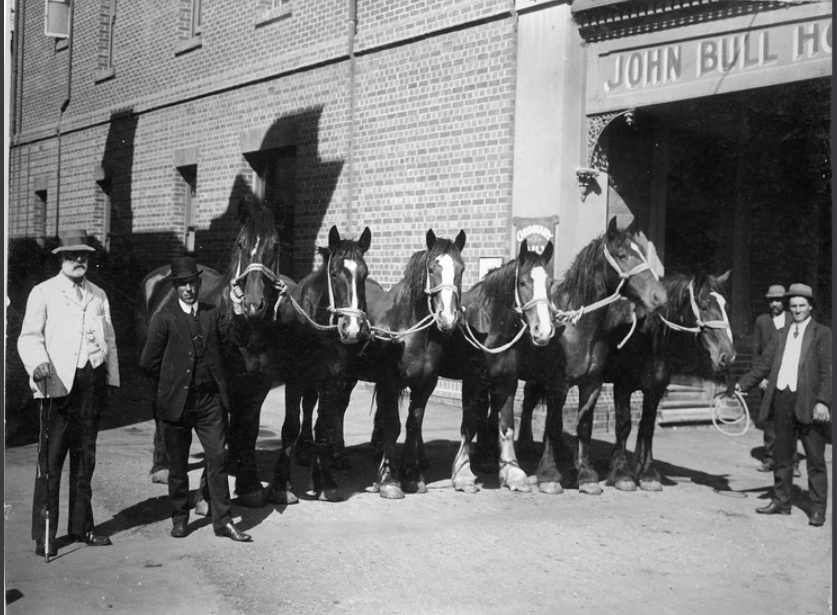Lyndavale Station

© Janet Lane, 2022. Image: ‘A team of six draught horses standing in the yard of the ‘John Bull Hotel’, 69 Currie Street, Adelaide with their handler and three other men. The hotel existed from 1853 and was demolished in 1958. 1914.’ State Library S.A.
Read our history of Lyndavale Station to understand more about the history of our foundation generation Walers. A list of the Lyndavale Walers we know about can be found here.
Lyndavale, on the Maratjura waterhole, was established in 1929 by William Leslie Pearce, known as Snowy Pearce; he had it throughout the1930’s and early 40’s. He died in Alice Springs in 1941 or 42 (legal notices for claims put out in March 1942). Pearce had horses, Hereford cattle and sheep on Lyndavale (sometimes written as Lynda Vale in old records)
The Stanes family has owned Lyndavale, 260 km sou-west of Alice Springs since the early 1940’S. Lyndavale is 3,782 square kilometres in size (following subdivision from Erldunda station in 1987). Sidney Stanes also owned Erldunda. His son was also named Sid.
Sidney Stanes (1863-1969) was an experienced cattle and horseman. He installed the massive boiler and engine at the cyanide works at Arltunga, among other jobs. Then established Hamilton Downs with Ted Harris, and sold his share in that to buy Erldunda in 1920. The family eventually moved to Lyndavale, where they still are.
Erldunda of 2,071 square kilometres, was first taken up by Richard Warburton. It was arguably the best Waler breeding station in Australia. The horses were superlative. Great conformation, very hardy, and importantly, sublime temperaments. Warburton’s brand of W in a circle, was famous throughout Australia and India. The Stanes family who owned the station next, then moved to Lyndavale, also had this brand.
As his horses roamed unfenced, some ended up as brumbies. Great horses. Richard Egerton Warburton, after running Erldunda for some time and putting water on there (the area had no water when he took it up) retired to Adelaide where he died in 1918. His horses had been sent to the sales for years and commanded top prices. He’d put good Suffolk Punches on there, Ensign and Chieftain (Dangar bred), in 1903. He also got a Suffolk Punch sire from George Brookman of Adelaide, who stood Rendelsham Collegian. Warburton thought very highly of this sire. Thoroughbreds of staying lines, and in 1883 a much admired, grey, active Percheron stallion to improve his stock, which threw top price getters. After him, a grey that was said to look like a Clydesdale. He also got two sires from Owen Springs. Replaced them with a good sire from Strangways Springs Station, bred there by James Allen, another great horseman who’d started a horse station north-east of Warrina.
In 1900 he got an Arab sire by Rafyk, from Sir Penn Boucault, a famous line. This Arab survived well, unassisted, in the tough country and threw some good horses. Also got a light draught stallion from Alan McFarlane in the Lakes district of South Australia. . Also bred his own sires. In the early 1890’s he’d got a blood sire from Irracowra on the Finke – a dark bay, stocky, not high, by Traveller by Emulation out of a Barossa mare going back to Fisherman. His mares were mostly all halfbreds, obtained initially in South Australia from Vanitsaart and Glen of Mayurra. Erldunda also ran a small mob of Hereford cattle, about 1,000 head. Horses were their main livelihood.
Warburton drove mobs of horses out to Oodnadatta for railing to the sales. John Egerton Warburton, his nephew, often took these horses through. He had taken over managing Erlunda for Richard as he grew older. In 1909 for example he took 303 Erldunda horses to the famous John Bull Bazaar in Adelaide, where they commanded good prices, some being bought for the mines and other heavy work, being good artillery sorts. In 1912 drover J. Cummings took 114 to Oodnadatta, they filled 14 train vans, and were sold by Barkers. Despite a drought, no feed on the last 1300 miles of the droving trip, they arrived in good condition. John Warburton took over the Erldunda pastoral lease after Richard died.
Jim Robb also bought Erldunda horses to sell to India for example in 1932. At this stage it had been bought by the Sidney Stanes family – they too bred and sold horses for the India trade. They bought it in 1920, keeping the excellent standards up. They also bred and sold cattle and often got best prices at the sales.
Today there’s a roadhouse at Erldunda.